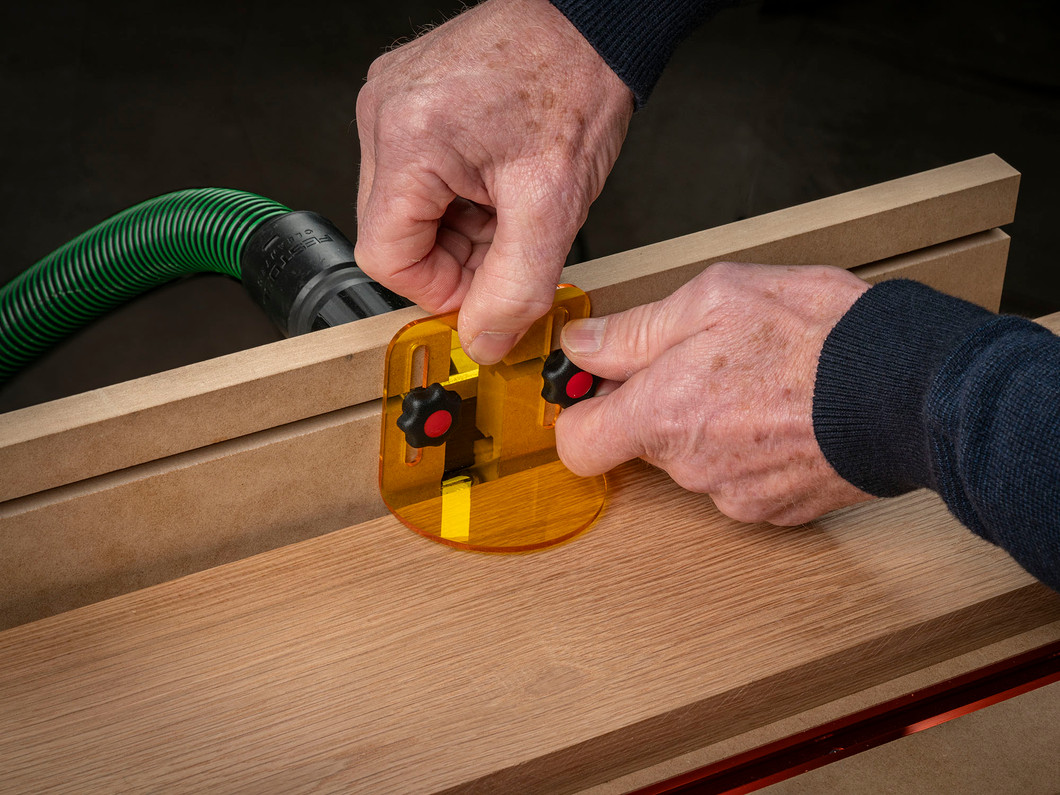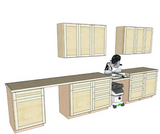Router Dust Collection: How to Tame One of the Dustiest Tools in Your Shop
Routers are among the most versatile tools in a woodworker’s shop—but they’re also some of the messiest. Whether you’re flush trimming, edge profiling, or routing dados, the fine dust and chips produced by a router seem to go everywhere. And unlike larger stationary tools, routers often operate in open-air configurations, making it difficult to contain that debris.
Controlling router dust isn’t just about keeping your workspace tidy. Fine airborne dust poses a long-term health risk and can interfere with tool performance and finish quality. In this blog, we’re taking a closer look at the unique challenges of collecting dust from routers—breaking down why it’s so difficult, which router operations are the worst offenders, and what solutions actually work in real-world shops.
If you haven’t already read our general guide to workshop dust collection, we recommend starting there to understand the broader principles behind airflow, filtration, and system performance. Then come back here to tackle one of the most stubborn sources of dust in the shop.
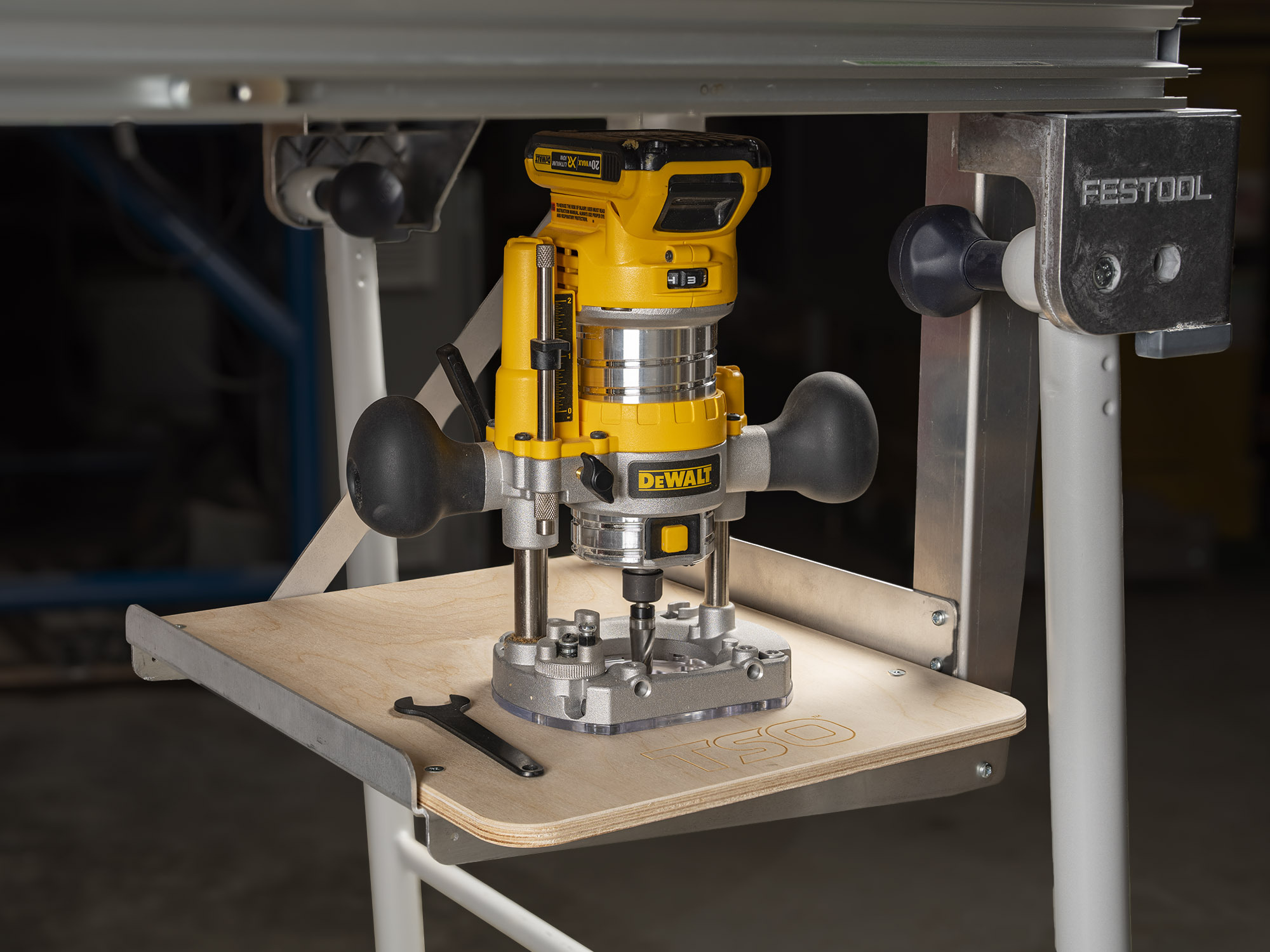
Why Routers Are So Challenging for Dust Collection
The problem with router dust starts with physics. A router bit spins at incredibly high speeds—typically 8,000-25,000 RPM depending on the router size and bit diameter—ejecting fine dust and chips in every direction. With handheld routers, there's usually no cabinet or shroud to contain the debris, unlike stationary tools such as table saws or jointers. While router tables can include built-in dust collection cabinets (like the Incra CleanSweep system), handheld routing operations leave you moving freely around the workpiece with minimal containment options.
To make things more complicated, there’s no one-size-fits-all solution. Router use varies widely:
- Handheld routers are used for edge shaping, trimming, and flush work—often in the open air.
- Plunge routers are used for mortising and trenching, where chips can get trapped in deep cuts.
- Router tables generate dust both above and below the table surface.
- CNC routers produce massive volumes of dust over extended runs and require high-CFM systems.
Because many routing operations leave the bit exposed or lack a sealed collection point, it’s difficult to create the kind of airflow needed to capture debris effectively at the source. This makes routers one of the most frustrating tools to manage in any dust collection setup.
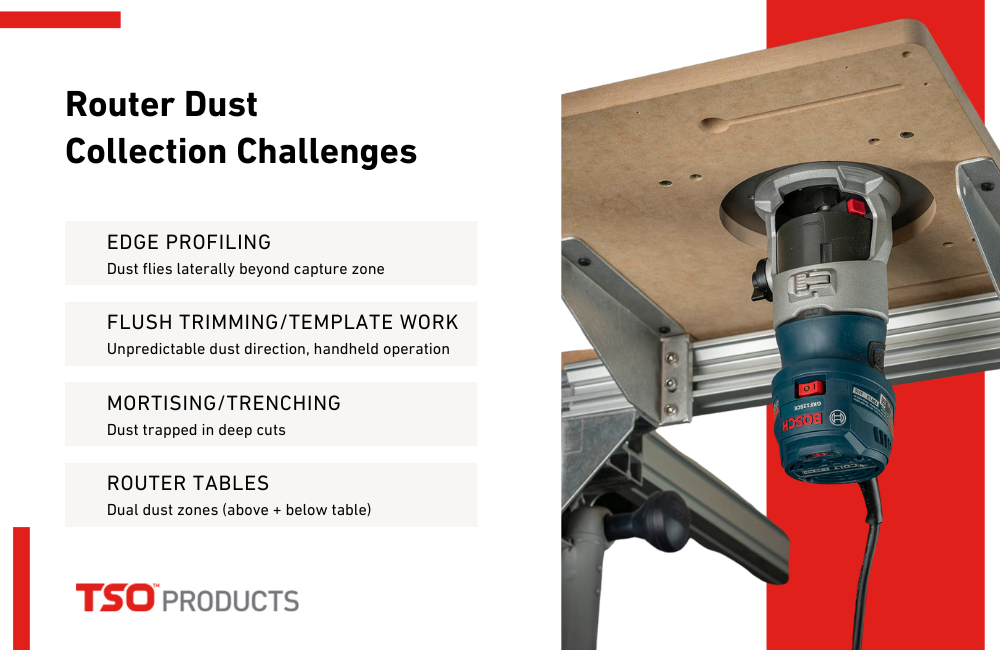
Router Use Cases & Their Dust Collection Challenges
Not all routing operations produce dust equally. In fact, each use case creates its own set of dust collection challenges. Understanding where and how the dust is generated is the first step toward managing it effectively. Below are the most common router applications and what makes them particularly difficult to control.
Edge Profiling
Edge profiling (shaping the outer edges of a board with a roundover, chamfer, or ogee bit) tends to launch chips and fine dust laterally, well beyond the capture zone of most dust ports. Because the router is moving along the edge, there's often little in the way of containment.
Solutions:
- Use half-dome guards that partially enclose the bit while still allowing movement along the edge.
- Router fences with integrated dust ports can help direct suction right where the chips are thrown.
- Minimize the distance between the dust port and the bit to maximize capture.
Flush Trimming / Template Routing
In this setup, you're often using a bearing-guided bit to match one piece to another, such as trimming veneer or duplicating a workpiece with a template. The router is handheld, and the work can be in any orientation—making dust direction unpredictable.
Tips:
- Look for vacuum shroud attachments that surround the bit and offer 360-degree capture.
- Use a router table if you have one available—it provides a dedicated suction point beneath the template routing work that handheld operations can't match.
- Consider using upcut spiral bits instead of downcut bits to help eject chips upward into the airflow path.
Mortising / Trenching
When routing deeper grooves or pockets into the workpiece—especially using plunge routers—dust tends to accumulate inside the cut. Downcut spiral bits only worsen this by pushing debris downward, packing it into the trench.
Recommendations:
- Choose plunge routers with dust ports located close to the bit.
- Rout in multiple shallow passes to allow dust to clear between cuts.
- Some specialty bases include internal baffles to direct suction right into the trench as you cut.
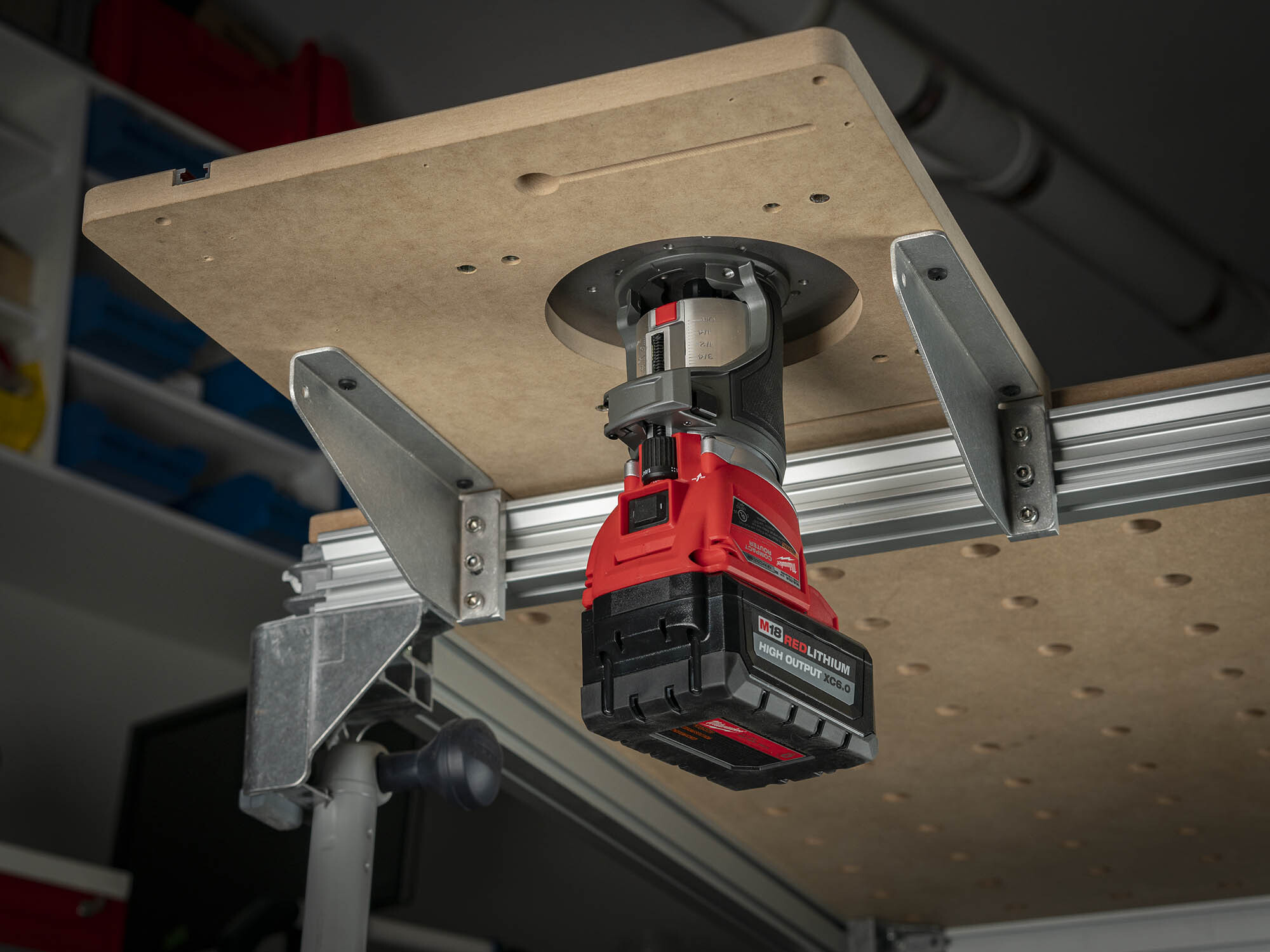
Router Tables
Router tables generate dust in two problem areas: above the table at the bit and below the table at the motor. Most shop vacs or collectors are only connected to the cabinet base, leaving the top surface exposed. Without a dual-extraction approach, a significant portion of fine dust ends up airborne.
Ideal Setup Includes:
- An above-table guard with an integrated dust port for bit-level collection.
- A sealed base cabinet with under-table extraction.
- An airflow strategy that pulls dust downward through the fence and cabinet, minimizing fine particles escaping into the shop air.
Tools & Accessories That Improve Router Dust Collection
Once you’ve identified the problem areas, the next step is equipping your setup with accessories designed to manage router dust. Here are some of the most effective tools making a real difference.
Router Dust Ports and Shrouds
Many modern routers come with built-in dust ports—but not all are effective.
Key Consideration:
- The closer the dust port is to the bit, the more effective it is. Even a small gap can reduce suction dramatically.
- Look for designs that seal tightly to the router base or workpiece.
Vacuum Attachments
Because router dust collection relies on high static pressure more than high airflow, shop vacs are often a better choice than large dust collectors for router-specific setups—especially handheld routing.
Recommendations:
- Keep hose runs short—under 6 feet when possible—to reduce pressure loss.
- Secure the hose to the tool in a way that doesn’t impede movement during routing.
Router Table Cabinets
A well-designed router table cabinet serves two purposes. It isolates the router from your shop air and creates a controlled space for dust collection.
Upgrades to Consider:
- Seal gaps in the cabinet with weather stripping or foam.
- Use magnetic or gasketed access doors to contain dust while maintaining serviceability.
- Route cabinet airflow toward the dust collector intake using internal baffles or sloped floors.
Cyclone Separators (for Shop Vac Setups)
Fine router dust clogs filters quickly. A cyclone separator installed between the router and the shop vac will remove the bulk of chips before they reach the vacuum.
Why It Matters:
- Extends filter life and maintains consistent suction.
- Makes disposal easier and reduces maintenance time.
- Popular models include Dust Deputy and Festool Systainer Cyclone.
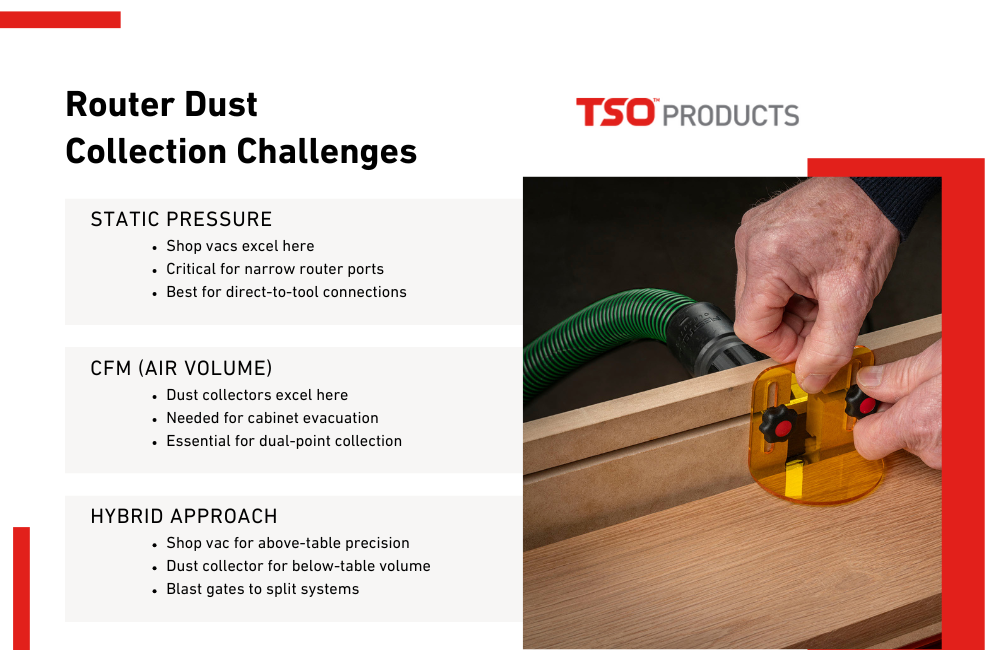
Dust Collection System Matching: Shop Vac vs. Dust Collector
Choosing the right system depends on how you're using your router. Here’s how different setups match up with common dust collection options:
|
Setup Type |
Ideal System |
Why |
|
Handheld router |
Shop vac |
High static pressure is necessary for small port and close-range suction. |
|
Router table |
Shop vac or hybrid |
Needs suction above and below the table. Shop vac for precision, dust collector for volume. |
|
CNC router |
Dust collector |
High CFM is essential for clearing large amounts of dust during extended cuts. |
CFM vs. Static Pressure Refresher
As mentioned in our general dust collection guide, router dust collection requires both adequate static pressure and sufficient CFM—the balance depends on your specific setup. Small handheld router ports need high static pressure to overcome restriction, while larger router table cabinets need adequate CFM to evacuate the enclosed space effectively.
Shop vacs excel at static pressure, making them ideal for direct-to-tool connections with narrow ports and short hose runs. However, a 1 HP shop vac may lack the CFM needed for larger router table cabinets or dual-point collection (above and below the table simultaneously). Traditional dust collectors move higher volumes of air but may struggle with the static pressure demands of small router ports.
When to Use a Hybrid Setup
- Use a shop vac for handheld routers and small router table setups with single-point collection.
- Use a dust collector for CNC routers, large router table cabinets, or when you need dual-point collection with adequate airflow.
- Consider a hybrid approach for serious router table users: a shop vac for above-table precision collection and a dust collector for below-table cabinet evacuation.
- Some woodworkers install blast gates to split the router table off from the central system and use a dedicated vac—especially helpful if the main collector is far from the router station or lacks sufficient static pressure for effective router dust capture.
Product Recommendations & Shop Upgrades
If you’re ready to take router dust collection seriously, investing in the right tools can make a significant difference. Here are a few options that pair perfectly with router setups:
- Router Table Inserts with Dust Collection Integration— Inserts that include porting options beneath the table help capture debris that otherwise escapes into the cabinet or the air.
- TSO Dust Collection Cart Plan— Designed by MWA Woodworks, these plans enable you to build a custom cart that integrates shop vacuum storage, cyclone separation, and tool support in one mobile unit.
Routers may be one of the messiest tools in the shop, but with the right strategy, they don’t have to be the hardest to manage. Understanding where the dust comes from—and how it moves—lets you build a setup that tackles each challenge head-on.
By collecting dust both above and below the bit, sealing up gaps, and choosing the right vacuum or dust collector, you can dramatically reduce airborne dust, improve tool performance, and protect your lungs.
Routing may never be a clean job—but with smart upgrades, it can be a much cleaner one.
Recent Posts
-
Router Dust Collection: How to Tame One of the Dustiest Tools in Your Shop
Routers are among the most versatile tools in a woodworker’s shop—but they’re also …2nd Jul 2025 -
Top Miter Saw Stands: From Budget to Professional Grade
A miter saw without proper support turns precision cutting into guesswork. After years of dealing wi …2nd Jul 2025 -
Workshop Dust Collection: Smarter Setups for Safer Shops
Wood dust is more than just a nuisance—it’s a real hazard. While sweeping up chips might …12th May 2025

